
Pakistan’s Air Quality Index (AQI) rose to unprecedented levels, prompting warnings in Punjab province as smog enveloped Lahore and Multan. According to Swiss air quality monitor IQAir, Lahore’s AQI rose to 760, while Multan’s reached 1,914, making it one of the most polluted cities worldwide.
Extreme pollution has authorities scrambling to control the smog, with limited success reported.
Lahore, which has been under a thick blanket of smog for several days, has seen many accidents due to road closures due to low visibility. In a serious incident on GT Road near Kalshah Kako, nine people were injured when a van collided with a parked truck.
The smog has forced the Lahore High Court to order a shutdown of all commercial activities till 8pm and closing of markets on Sunday, aimed at reducing pollution-causing activity.
In Multan, the situation reached what experts called “apocalyptic” levels, with the AQI crossing 2,000 on Friday morning. The concentration of PM2.5 – hazardous particulate matter that causes serious respiratory and cardiovascular problems – was recorded at 947 micrograms per cubic metre, almost 190 times higher than World Health Organization (WHO) guidelines. WHO considers PM 2.5 levels above five micrograms per cubic meter to be harmful.
In response, the state government is on high alert, implementing emergency measures to curb pollution levels. Public parks and museums in major cities are closed until at least November 17.
Officials have also faced criticism for failing to enforce preemptive anti-smog directives, with citizens often seen without masks despite severe air quality.
Multan, the largest city in southern Punjab, recorded an extremely hazardous air quality index (AQI) of 2,135 between 8 am and 9 am on Friday, according to IQAir data, Dawn reported. Later in the day, the AQI reading remained alarming, reaching 980 by 10pm – three times above the “dangerous” threshold of 300. Multiple monitors across Multan including WWF-Pakistan Office, Shamsabad Colony, and Multan Cantonment. , showed AQI levels as high as 2,316, 1,635, and 1,527 respectively.
Pakistani officials have blamed Lahore’s poor air quality on cross-border winds carrying pollutants from neighboring India, alleging that these winds have pushed smog levels to “dangerous” extremes.